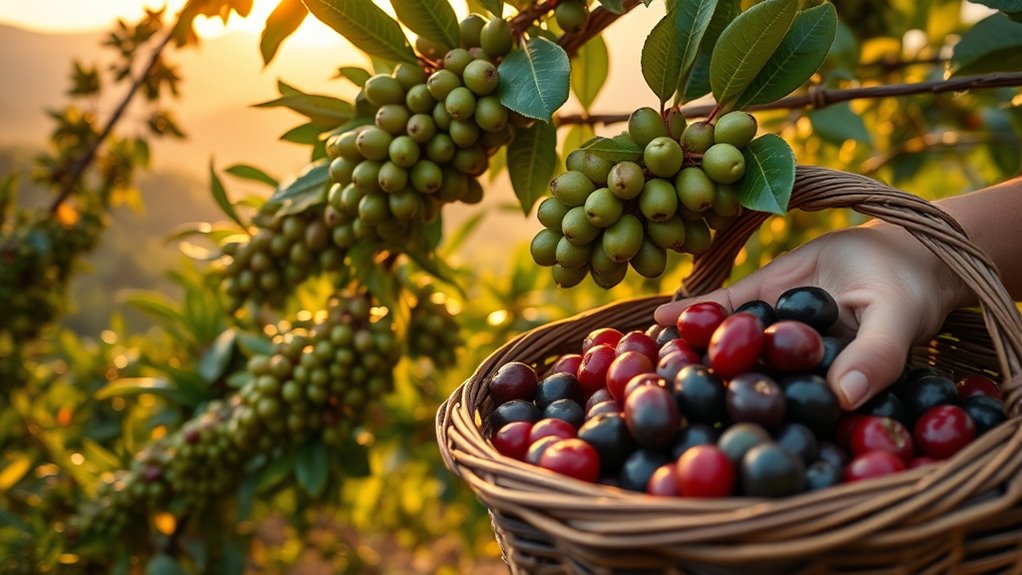From bean to cup, your coffee’s flavor is shaped by its origin’s unique environment. Soil type, altitude, climate, and water sources all influence how beans develop their taste, acidity, and aroma. Regions like Africa, South America, and Asia each offer distinct terroirs that create diverse profiles—from fruity and floral to earthy and bold. Understanding these factors reveals how each cup reflects its birthplace. Keep exploring to uncover how these elements craft your perfect brew.
Key Takeaways
- Terroir factors like soil, altitude, and microclimate influence bean development and impart unique flavor characteristics.
- High-altitude regions foster denser beans with brighter acidity and complex, floral, and fruity notes.
- Processing methods and post-harvest handling significantly impact the final flavor profile and aromatic complexity.
- Regional environmental conditions, including water quality and climate, shape the taste and consistency of coffee.
- Understanding origin-specific factors allows for better control over flavor development from bean to cup.
The Role of Terroir in Coffee Flavor Development
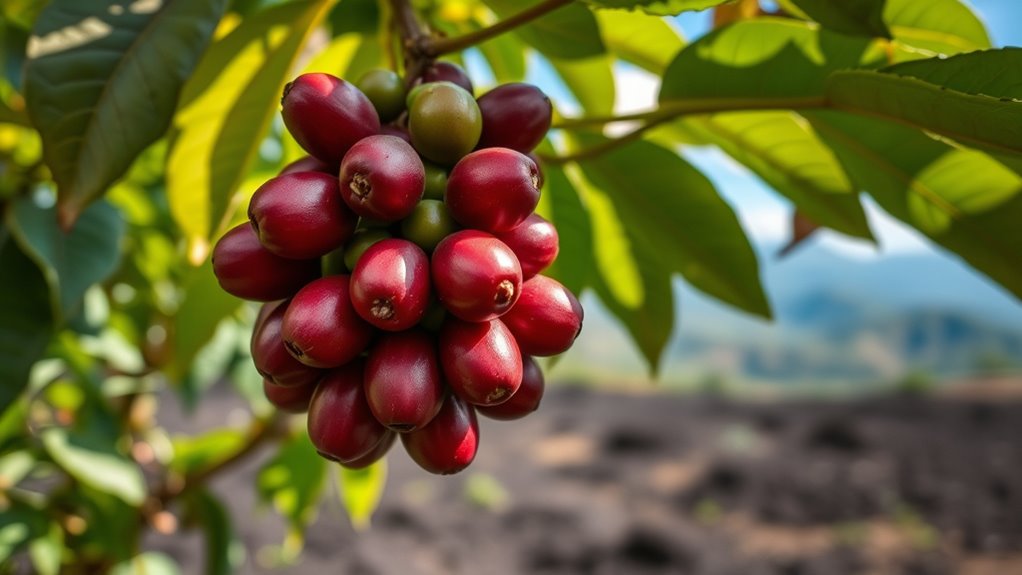
Terroir plays a crucial role in shaping the unique flavor profiles of coffee by integrating environmental factors that influence bean development. Soil composition, whether volcanic, loamy, or sandy, supplies nutrients that impact flavor intensity and bean growth. Elevation affects bean density and maturation speed, with higher altitudes producing denser beans rich in acidity and complex flavors. Climate, including temperature and rainfall, determines sugar accumulation, bean size, and moisture content, directly influencing taste. Microclimate variations, like sun exposure and cloud cover, add subtle nuances. Proximity to water sources stabilizes humidity and temperature, supporting consistent growth. These factors work together, creating distinct flavor profiles that reflect the unique environment where your coffee is cultivated. Additionally, understanding how relationships between environmental conditions and coffee cultivation affect flavor can enhance appreciation for coffee’s complexity. Recognizing the influence of environmental factors can also guide farmers in optimizing cultivation practices for desired flavor profiles. For example, soil nutrients can be managed through specific farming techniques to enhance particular flavor notes in the beans. Moreover, the use of specialized equipment in processing can further influence the final flavor characteristics by affecting fermentation and drying methods. Awareness of agronomic practices helps in understanding how different cultivation and processing choices impact the final taste.
Distinct Coffee Profiles Across African Regions
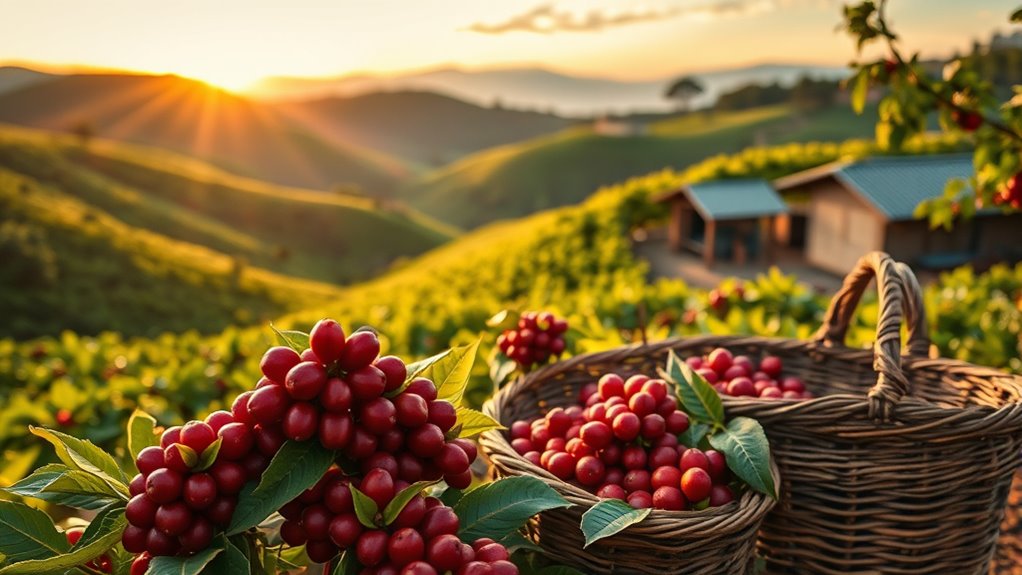
Across Africa, coffee flavors are shaped by regional environmental factors that give each area’s beans their distinct character. In Sierra Leone, Coffea stenophylla dominates, offering complex sweetness and medium-high acidity, with flavors ranging from peach and lemon to apricot. Kono and Kailahun produce resilient beans, gaining recognition for drought tolerance and quality. In the Democratic Republic of Congo, volcanic soils in South Kivu yield bright, chocolatey Arabicas, while rainforest-grown Ituri Robusta offers earthy, bold notes. Kenya’s high-altitude Central Highlands produce citrus and blackcurrant profiles, with misty Aberdare Mountains creating smooth, balanced cups. Ethiopia’s landrace heirlooms deliver floral, jasmine aromas and berry notes, with processing methods adding flavor complexity. Biodiversity in these regions influences soil health and coffee quality, contributing to the unique flavor profiles. Uganda’s Lake Victoria region focuses on robusta, while Mount Elgon’s Arabica offers winey acidity and floral tones. Additionally, the unique climate conditions across these regions significantly influence the development of distinctive flavor profiles in their coffees.
South American Coffee: Balance and Notes
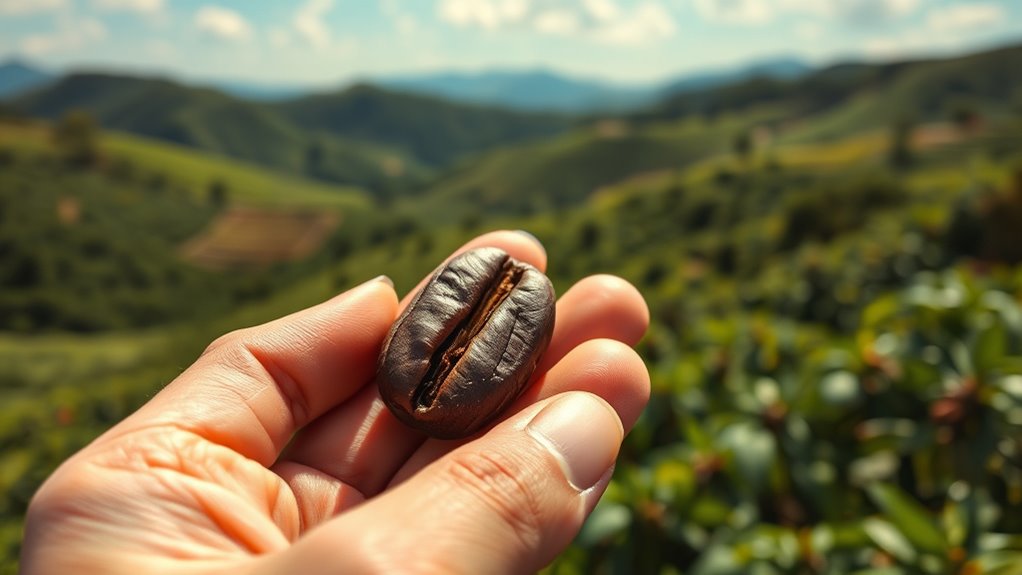
South American coffees are celebrated for their smooth, balanced flavors that appeal to a wide range of palates. Grown in rich volcanic soils at high altitudes, these beans develop complex, refined profiles. You’ll often notice a medium to full body with moderate to low acidity, creating a harmonious taste experience. Prominent flavor notes include floral hints, soft citrus, and mild nuts, offering a gentle sweetness that’s both inviting and nuanced. Regional variations add depth: Brazilian coffees tend toward nutty and chocolatey tones, while Colombian beans deliver caramel and nut sweetness. Peruvian and Ecuadorian coffees often feature bright citrus and floral nuances. Whether processed as washed, natural, or honey, these coffees are typically roasted medium to Vienna, emphasizing their inherent balance and aromatic complexity. Their flavor profiles are shaped by diverse regional farming practices and processing methods, contributing to the unique character of each origin.
Unique Terroirs of Asian Coffee Origins
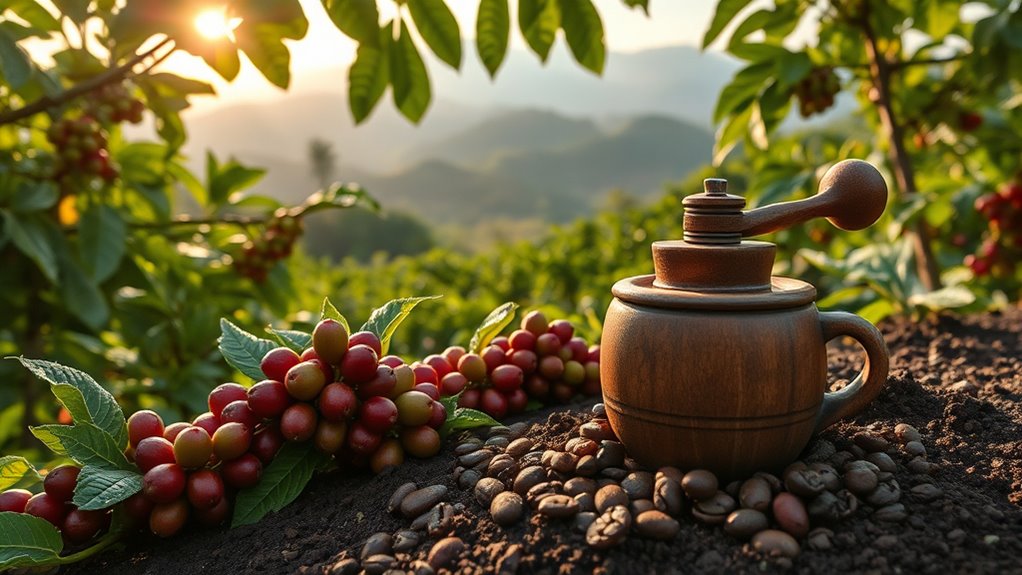
The diverse landscapes and climates of Asia create a wide range of coffee flavors, with each region offering its own distinctive character. In Vietnam, the dominance of Robusta results in a bold, earthy profile that’s perfect for espresso and traditional blends. Indonesia’s islands, like Sumatra, bring earthy, spicy, and smoky notes thanks to their unique terroirs. India’s monsooned coffees, such as Malabar, develop a rich body and reduced acidity through monsoon processing, while Thai high-altitude regions produce floral, bright Arabicas with complex flavors. China’s long history of cultivation focuses on high-quality Arabica beans, often showcasing delicate, nuanced profiles. Soil composition, climate, and microclimates all contribute to this regional diversity, making Asian coffees remarkably varied and intriguing for discerning palates.
How Altitude and Climate Influence Coffee Characteristics
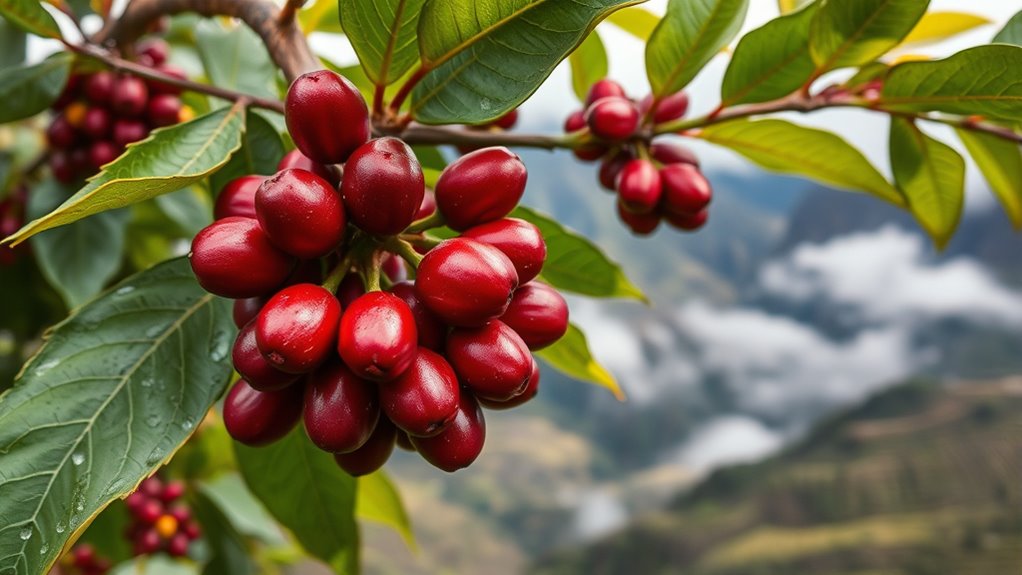
Altitude and climate play crucial roles in shaping coffee’s unique characteristics. Higher elevations slow down the maturation process, allowing beans to develop denser structures and more complex sugars. This results in vibrant acidity, floral and spicy flavors, and a wine-like quality. Cooler temperatures, typically between 16-23°C, support ideal flavor development. Regions like Colombia, Ethiopia, and Kenya benefit from these high-altitude conditions, producing coffees with bright, lively profiles. Climate considerably influences growth; cooler, high-altitude climates promote slower growth, enhancing quality, while warmer, lower-altitude environments lead to faster maturation and milder flavors. Consistent water and nutrient management further refine these characteristics. Proper climate management is essential for maintaining the delicate balance needed for high-quality coffee production. Altitude and climate, thus, are key in creating the distinctive flavor profiles associated with high-quality, region-specific coffees.
Farming and Processing Techniques That Shape Taste
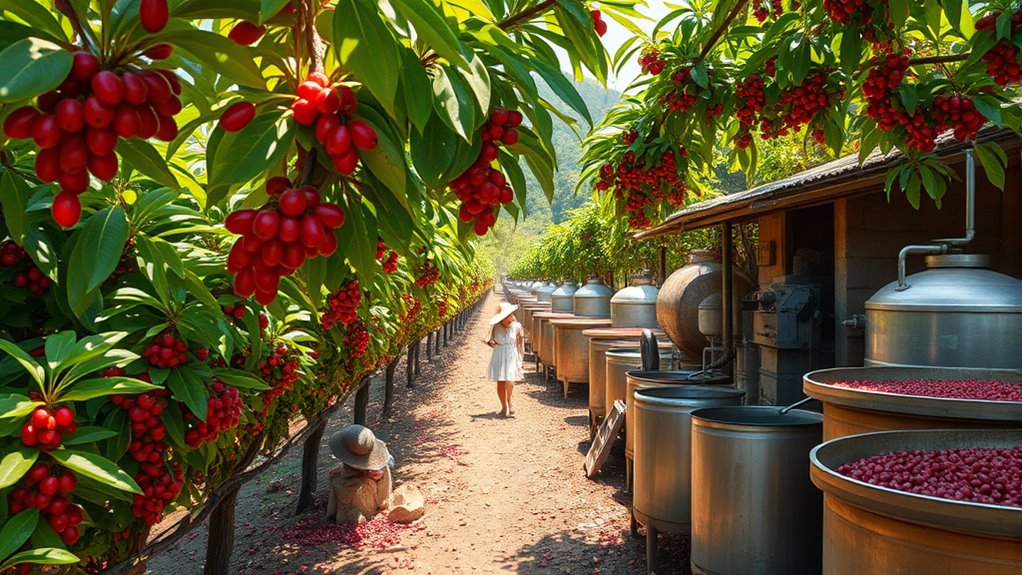
Farming and processing techniques directly shape the flavors you experience in each cup. Your farming practices, like shade management and pest control, influence bean health and quality, impacting flavor. Proper irrigation prevents water stress, maintaining ideal taste. Sustainable methods promote healthier soil, enhancing natural flavors, while reduced pesticide use results in a cleaner, more authentic profile. Fertilizer application supports healthier plants and better taste. Predictive modeling can also be employed to optimize farming practices based on data analysis, leading to improved flavor outcomes. Incorporating soil health management practices can further enhance bean quality and flavor complexity. Techniques such as fermentation processes further influence the development of unique flavor notes, making each batch distinct. Processing methods also play a crucial role: wet processing yields bright, clean, and acidic flavors; dry processing produces bold, fruity, full-bodied cups with wine-like notes; honey processing offers a balanced sweetness and body with fruity and honey hints. Advanced techniques like anaerobic fermentation and carbonic maceration create intense, complex, and unique flavor profiles, adding depth to your coffee experience. Additionally, butter characteristics such as the removal of milk solids during clarification can influence the stability and flavor development of dairy products used in coffee beverages. Understanding processing equipment and its impact on flavor extraction can further refine the final taste profile of your coffee.
The Impact of Growing Conditions on Coffee Complexity
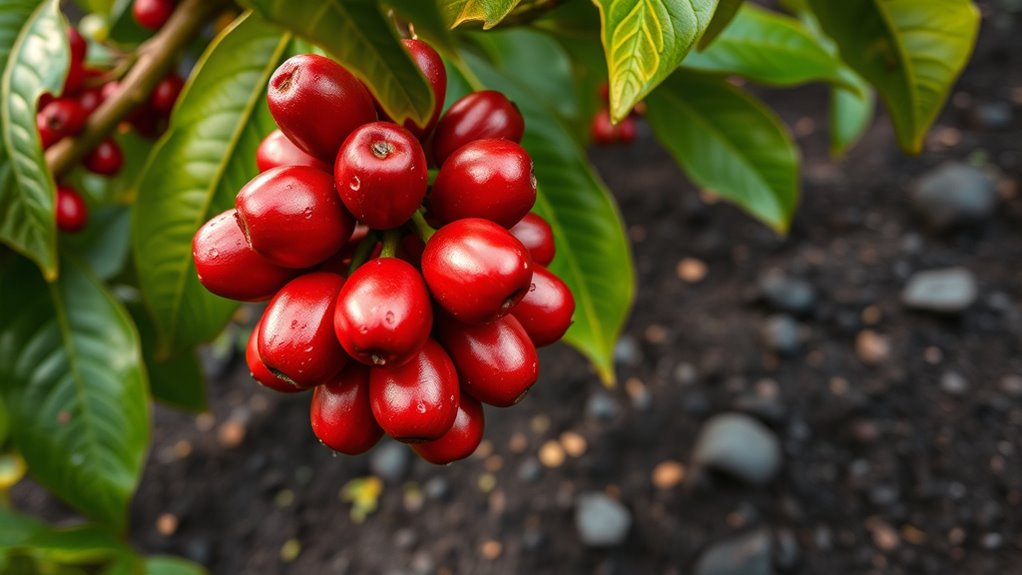
Growing conditions play a crucial role in shaping the complexity of your coffee’s flavor profile. If you’re in a tropical region with balanced rain and sunshine, your coffee benefits from consistent growth, producing stable flavors. At higher altitudes, cooler temperatures slow growth, allowing beans to develop more sugars and intricate flavors, resulting in brighter, more complex profiles. Regional variations, like misty Costa Rican mornings, boost crisp acidity and layered notes. Soil composition also influences taste—fertile, well-drained soil enhances flavor depth, while unique terroirs create distinct regional profiles. Adequate water and moisture support healthy development, but drought can cause uneven ripening, impacting flavor consistency. Vetted materials suggest that using durable, high-quality materials for planting and processing can also influence the final flavor profile. Additionally, proper fermentation techniques can accentuate or mellow certain flavor characteristics, further shaping the coffee’s profile. The microclimate within growing regions can create subtle differences in flavor, making each coffee unique. Moreover, the care and handling during harvest and post-harvest processing significantly affect flavor development. Studies also show that shade-grown coffee can develop more nuanced flavors by reducing stress on the plants. Ultimately, the combination of climate, elevation, soil, and water conditions shapes the unique complexity of your coffee.
Frequently Asked Questions
How Does Fermentation Affect Coffee Flavor Beyond Terroir Influences?
Fermentation notably impacts coffee flavor beyond terroir influences by developing acidity, sweetness, and fruitiness. It breaks down mucilage, releasing organic acids that brighten the taste and enhance aroma. Controlled fermentation boosts sugar breakdown, adding layers of caramel or honey notes. It also fosters microbial activity, which introduces fruit-forward and complex flavors, like berry or tropical notes. Proper fermentation management ensures desirable flavors and prevents off-flavors, shaping a unique and refined coffee profile.
What Role Do Local Cultural Practices Play in Shaping Coffee Profiles?
They say, “Culture is the backbone of tradition,” and that’s true for coffee. Your local rituals, like Ethiopian slow roasting or Colombian communal harvesting, deeply influence flavor. These practices preserve heritage, enhance handling techniques, and create unique profiles. By embracing traditional methods and community customs, you develop distinct taste characteristics that reflect regional identity, making every cup a flavorful story of history, land, and shared passion.
How Do Post-Harvest Processing Methods Alter Regional Flavor Characteristics?
You see, post-harvest processing methods directly influence regional coffee flavors. For example, natural processing enhances fruity and sweet notes, especially in African coffees, while washed processes highlight bright acidity found in Central American beans. Honey and experimental processes create balanced profiles with unique flavors. Climate, altitude, and water access also shape how these methods develop, giving each region its distinctive taste, appealing to diverse consumer preferences and market trends.
Can Climate Change Significantly Shift Traditional Coffee Flavor Profiles?
Climate change can definitely shift traditional coffee flavor profiles. You might notice beans losing their brightness, acidity, and floral notes due to rising temperatures and water stress. Warmer conditions can also favor caramelized, chocolatey flavors, but may reduce aromatic complexity. As a result, the unique regional tastes you love could become more muted or altered, prompting farmers to adapt through altitude shifts, shade management, or new cultivars to preserve flavor integrity.
How Do Different Roasting Techniques Enhance or Mask Regional Flavor Nuances?
You can see that different roasting techniques either enhance or mask regional flavor nuances in coffee. Light roasts preserve those unique regional characteristics by maintaining acidity and complex profiles, while medium roasts balance and smooth out flavors. Dark roasts often mask regional nuances with smoky, bitter notes, especially if overdone. By carefully controlling heat and time, you guarantee the roast complements rather than overwhelms the coffee’s natural regional flavors.
Conclusion
So, next time you sip that perfectly brewed cup, remember—it’s not just about your barista’s skill. All those tiny details from terroir to processing shape your coffee’s unique personality. Ironically, the very things that make each cup special—climate, altitude, farming methods—are often out of your control. Yet, it’s those unpredictable quirks that turn a simple bean into a delightful, complex experience. Cheers to the fascinating chaos behind every great coffee!
